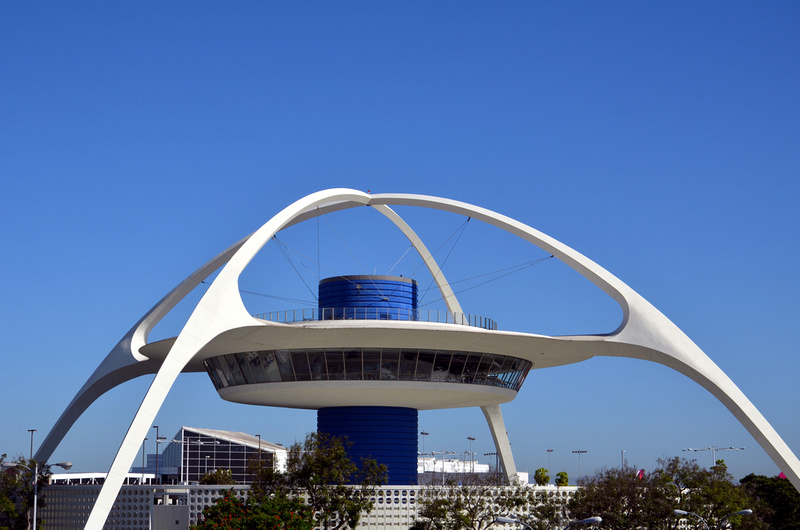Theme Building, LAX
The Theme Building is an iconic modernist structure at Los Angeles International Airport (LAX). It is recognised as an example of ‘Googie’ architecture which emerged in Southern California during the late-1940s. The ‘Googie’ movement was influenced by the futurist designs of car culture, jet travel, the emerging Space Age and the Atomic Age.
Completed in 1961, the Theme Building takes the form of a flying saucer that has landed on four legs. Flying saucers were a common aesthetic form for the ‘Googie’ movement, which often tried to symbolise motion and flight.
The original design was created in 1959 by Pereira & Luckman, and visualised the terminal buildings of LAX and the parking structures connected to a large glass dome. This proved to be too ambitious, and subsequent designs by Paul R Williams were refined with the terminals constructed elsewhere. The Theme Building marks the spot intended for the dome structure.
The building comprises a restaurant suspended from the centre by two 135 ft parabolic arches. These were the first structures in the United States to use supporting steel arches for such an application. However, the homogeneity of the crossed arches is a design illusion, as they comprise four steel-reinforced concrete legs topped with hollow stucco-covered steel trusses.
In 1997, Walt Disney Imagineering renovated the restaurant with a retro-futuristic interior and electric lighting. However, the restaurant closed in December 2013. The Observation Level is still open to the public.
In 2007, a large chunk of stucco fell from the eastern arch and smashed onto the restaurant roof. Subsequently, a 3-year repair project costing $14.3 million was undertaken, with retrofitting of a tuned mass damper to counteract seismic activity.
In 1993, the Los Angeles City Council designated the building a historic-cultural monument. It remains one of the city’s most iconic structures.
It served as the inspiration for U2’s ‘Claw’ stage design for their 2009-12 ‘360 tour’, which was the largest stage ever toured. For more information, see U2 – 360 (2009-12).
[edit] Related articles on Designing Buildings Wiki
Featured articles and news
RTPI leader to become new CIOB Chief Executive Officer
Dr Victoria Hills MRTPI, FICE to take over after Caroline Gumble’s departure.
Social and affordable housing, a long term plan for delivery
The “Delivering a Decade of Renewal for Social and Affordable Housing” strategy sets out future path.
A change to adoptive architecture
Effects of global weather warming on architectural detailing, material choice and human interaction.
The proposed publicly owned and backed subsidiary of Homes England, to facilitate new homes.
How big is the problem and what can we do to mitigate the effects?
Overheating guidance and tools for building designers
A number of cool guides to help with the heat.
The UK's Modern Industrial Strategy: A 10 year plan
Previous consultation criticism, current key elements and general support with some persisting reservations.
Building Safety Regulator reforms
New roles, new staff and a new fast track service pave the way for a single construction regulator.
Architectural Technologist CPDs and Communications
CIAT CPD… and how you can do it!
Cooling centres and cool spaces
Managing extreme heat in cities by directing the public to places for heat stress relief and water sources.
Winter gardens: A brief history and warm variations
Extending the season with glass in different forms and terms.
Restoring Great Yarmouth's Winter Gardens
Transforming one of the least sustainable constructions imaginable.
Construction Skills Mission Board launch sector drive
Newly formed government and industry collaboration set strategy for recruiting an additional 100,000 construction workers a year.
New Architects Code comes into effect in September 2025
ARB Architects Code of Conduct and Practice available with ongoing consultation regarding guidance.
Welsh Skills Body (Medr) launches ambitious plan
The new skills body brings together funding and regulation of tertiary education and research for the devolved nation.
Paul Gandy FCIOB announced as next CIOB President
Former Tilbury Douglas CEO takes helm.
UK Infrastructure: A 10 Year Strategy. In brief with reactions
With the National Infrastructure and Service Transformation Authority (NISTA).

























Comments
The restaurant never revolved, according to officials at LAX. It's a commin myth because of its shape.